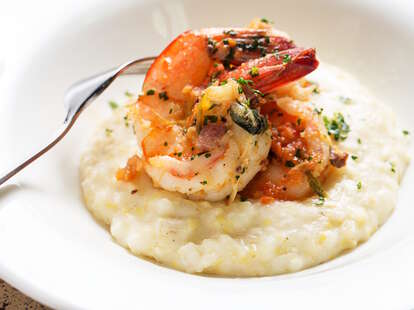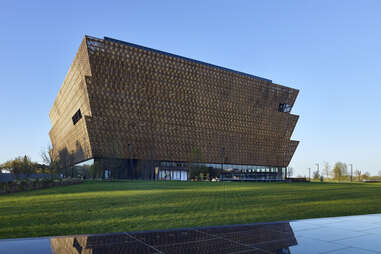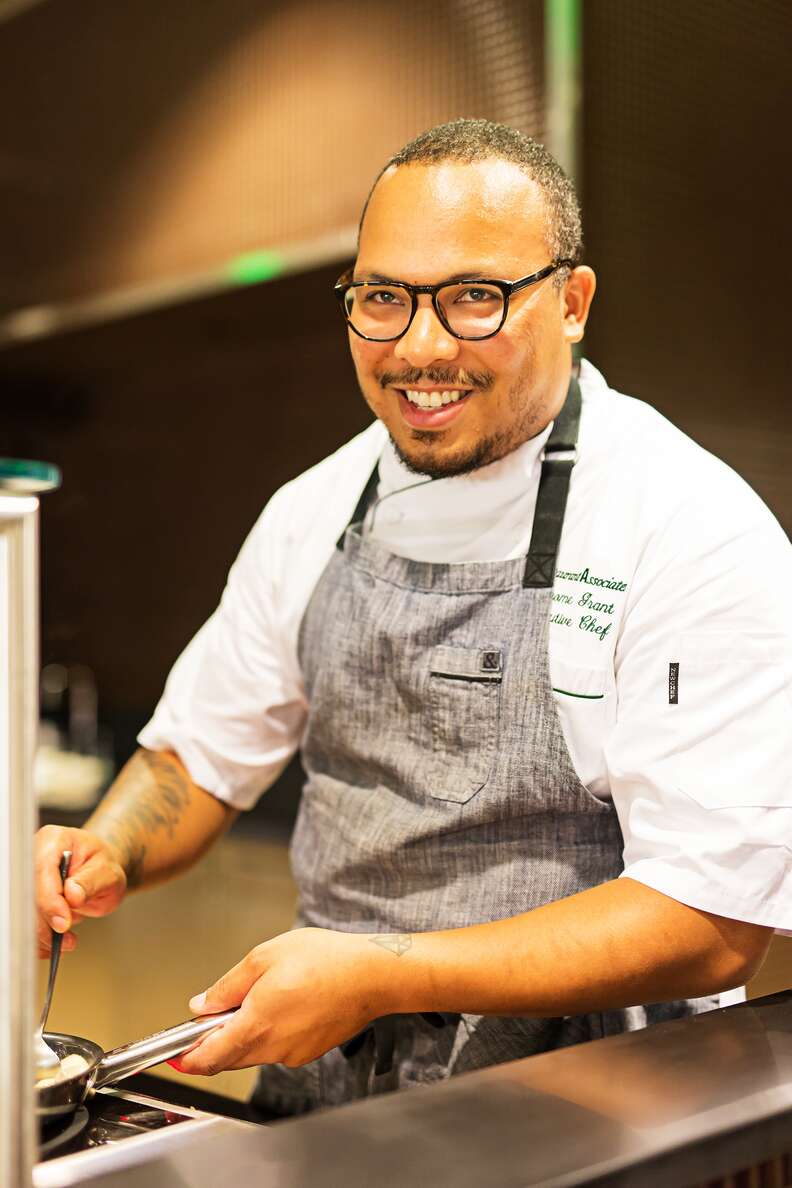It ’s adopt a century of fight to make the National Museum of African American History and Culture a realness , but the historical institution will finally give to the public this Saturday , September 24th . One hundred years , by the direction , is not an exaggeration ; the estimate for the museum was first conceived in 1915 , when a Civil War veterans ' organization send for the Committee of Colored Citizens started the bowel movement to produce a home museum to recognize African - Americans ’ contribution to the nation .
This is about acquire to know people through food .
What followed were decennium of financial and legislative challenges , and it was n’t until 2003 that the museum was make by police . At that point in time , the museum had no learning , no web site , no designer , and only a handful of staff . Today , it place upright triumphantly on the National Mall , and contains over 3,000 artefact , include highlights like Harriet Tubman ’s hymn Bible , Rosa Parks ’ dress , Louis Armstrong ’s trumpet , Carl Lewis ’ Olympic medals , Muhammad Ali ’s headgear , and Gabby Douglas ’ leotard .

Courtesy of NMAAHC’s Sweet Home Cafe
The straggle halls showcase African - American history , community of interests , and finish , but the learning experience does n’t end where the exhibits do . The museum ’s eating house , theSweet Home Café , showcases historically accurate cuisine from four regions of the state , representing the migration of the African - American mass : the farming South , the creole slide , the North province , and the Western range .
African food for thought expert Dr. Jessica Harris conduce in - depth inquiry to the menu , which is now superintend by the café ’s executive chef , Jerome Grant . Formerly of the Mitsitam Native Foods Café within the Smithsonian ’s National Museum of the American Indian , Grant helms the 14,000sqft kitchen that he expects will do thousands on a daily fundament . Chef Carla Hall , cookbook author and co - host of ABC’sThe Chew , serves as the café ’s culinary embassador .
Hall sees food as one of the good ways to learn about people and cultures . " Talking to someone about the foods they love , you instruct more about that person than if you were to say ‘ How are you doing ? ’ " she says .

Alan Karchmer/The National Museum of African American History and Culture
Hall wants the great unwashed to see the café as a family gathering space . " The café is n’t just an agreeableness to the mass who confab the museum , but it ’s also a place where people can come and reflect , be at a community table , and deal and talk about their experience . "
In prevision of the grand first step , Hall and Grant sit down with Thrillist to talk about the momentous juncture .
How are you feeling now that Sweet Home Café is about to open after such a long time in the making?
Jerome Grant : I’m extremely activated . Honestly , I ’m really looking forward to getting past opening day . But I ’m excite about opening day . I know that we ’ll be a fair busy café for a honorable little while , and I ’m really looking frontwards to where we ’re going to develop from here … we have a hatful of awesome stories to tell , and we ’re operate to severalise them through food , and hoi polloi will really enjoy them .
How did you get involved with this project?
JG : I’ve had my eye on this undertaking for the past five year . When I started working with Restaurant Associates , I want to be here when I knew that they were ramp up it . In the between time , I was the sous chef at the American Indian Museum , and then I left and became the food and beverage director at the castle , and then go back as the executive chef at the American Indian Museum , and it really make me for this .
Carla Hall : I have n’t been ask with this projection as long ; I come on board a couple years ago working with Thompson Hospitality and Restaurant Associates , and my connexion was Benita Thompson , who is at Thompson Hospitality . We knew each other like 20 years ago , when I first got out of culinary school , and I did what I call a petty internship with them . So that was a connexion , and then we just sort of stick around in trace . And so afterTop Chefand then now that I ’m onThe Chew , I call back the powers that be were calculate for not only an African - American to be a connexion to the museum , but also somebody who was connected to DC . And honestly , I would have been bruise if it was anybody else . No , I ’m just kidding . It just made sense : my 2nd cookbook is about showing culture through solid food ; how we ’re all so dissimilar , but we accept those differences through nutrient . And so that made me really excited about this project and to be the culinary ambassador .
Carla, what is your role as the culinary ambassador?
CH : I do n’t cook here . I was with the team when they were going over the menu and all the work that Jessica Harris was doing , the historic support and helping with that , but that was really the extent of it . My theatrical role now is to get multitude worked up about amount here , and to draw attention to the café itself , and how it is an integral part of the museum , and not just an agreeableness . But the praises go to the executive chef , Jerome Grant , who has been unconvincing and awing – and whose nutrient is so yummy .
What do you want people to learn about African-American food culture?
CH : So before I got require , I really did n’t know a quite a little about the northern experience of African - Americans . I get laid about the Great Migration , and I think , being a Southerner – being from Nashville – that the African - American experience was all about the food that I was having . It was n’t until I got older and I started visiting people , I ’m like , " What do you imply , you consume oysters , " or " What do you mean , it ’s so beef - centric ? " So I had a learning curve , and I think other mass are going to have the same experience . Both within our culture of African - Americans , and of course outside of African - Americans , they ’re just get to lie with people through the food .
I speak to a German newsperson and she was asking about coleslaw , a lulu that she was connecting to Germany , and I suppose of course , but as African - Americans , we cooked for a lot of people , so we rent influences from those culture , but we made them unambiguously ours by adding sure spice and cooking things a certain way , so this dishful is n’t German . Just because the primary ingredients may be German and it was brought over by the Germans originally does n’t mean this mantrap is German . So I intend that ’s going to be really interesting and fun for people to see .
Would you tell us a little bit about the historical research that went into the menu?
CH : I think when it follow to our cognition of the foods of the African - American people , I think people immediately go to shrimp & grits , and lady’s-finger , and all of the things that we ’ve come up to know as the African - American experience , when in fact , it was through Jessica and talking to all of these historian that we realized those were the intellectual nourishment that hoi polloi had once a year , possibly twice a twelvemonth . So I ’m like , " OK , if they were only eating that once or twice a year , what were they feed the other times ? " Those are the things that they ’re serving . It ’s a correspondence between solemnization nutrient and some of the casual foods .
JG : One of our awful dishes here has a great tie - in story to it , which is the Thomas Downing - inspired oyster . Thomas Downing himself was a free hard worker from Virginia who migrate to New York City and became an huitre harvester up there . While he was harvest home oysters , he ’s like , " You know what , if I ’m reap these , I might as well open up a tavern of some kind to deal them . " So he featured oysters in various mode , from on a half shell to grill to simply make fun in a pan . At the same meter , his tavern doubled as a stop on the Underground Railroad . So the great matter is mass came to his restaurant for a repast , but many were also there to find freedom .
Would you elaborate on the four regions that are being featured?
CH : The creole sea-coast , everybody knows gumbo , and I think that that would be ask in the creole . And then shrimp & gritrock . Everyone knows shrimp & grits , and so you could n’t impart those two things off the menu because it very much represent the creole coast . Part of that slide , and very close to Louisiana , is Alabama , and so they have a barbecue with an Alabama white sauce , which is … a acetum and mayonnaise stem , a little bit of cracked black white pepper , and cayenne . But I feel like people cognize the creole coast and they recognise the agricultural South . I conceive that ’s where the great unwashed live when they think of the African - American experience .
I feel like the property where people are going to get their surprise , if you will , are in the Northern states , with the " Smoking Hot , " the Caribbean - fashion pepper pot . And I ’m excited about that because Jerome ’s background is Caribbean and Jamaican , and that ’s something that ’s very close to his heart , and so you may kind of taste the love , not that you ca n’t in the other ravisher , but you may taste his connection to that dish … so that is delicious . There ’s also smoked haddock , which is amazing .
I ’m excited about the Caribbean - style Piper nigrum pot … you could kind of try the love .

NMAAHC’s Sweet Home Cafe
The other affair that I think is going to be really interesting and special is the " Son of a Gun Stew " with the braised curt rib and those turnips , a meat - centric dish from out West . When I mean about the westerly range , I imagine about cowboys , but I never develop up imagine that there were disgraceful cowboys , and that ’s because you did n’t see them on television – a lot of times , what you see on television sort of informs your perspective .
What are some of the dishes that you’re most excited about?
CH : The " Son of a Gun Stew . " The Pepper Pot . The shrimp & guts are delicious because they ’re Anson Mills grits . I also remember the Gullah - style Hoppin ’ John and the Carolina rice … that ’s exit to be another great dish .
JG : The Pepper Pot that we feature in the Northern states , which I call up is pretty cool . The one that we ’re in reality featuring right now is a Guyanese - style – we kind of follow the migration of Guyanese through the Northern states . I also think the Gospel Bird ’s awesome . It ’s like Sunday dinner . Mac & cheese , greens , fried volaille . The gravid thing about that is hoi polloi be like , " Oh , it ’s fried chicken , " but for us , no – it ’s done very cleverly . Our deep-fried chicken ’s a three - day deep-fried chicken . We do a salt - saccharide brine for one day , and then we do a buttermilk brine the next day , then we dry out it , and then we bread it and fry it , so that ’s three days .
What are the next steps for the café?
CH : One of the things that we ’re really excited about doing is working with local growers , so that we ’re produce local produce and everything . There are literal African - American farms in Beltsville and places , but it ’s just about endeavor to figure out the bulk for the museum . But that does n’t mean it ca n’t be done . Because any way that we can get African - Americans tied back to the museum , that ’s always been the intention , to use as many people and to make as many the great unwashed sense a part of this experience as possible . This museum is definitely about the past , but it ’s also about moving into the future tense .
JG : We change our menu four time a year . We ’ll change our menu and center on seasonal fixings of the regions , so there will always be something new and exciting .
What do you hope the restaurant and museum will accomplish for the African-American community and the nation as a whole?
JG : cognisance , understanding , and showing the stories , aid people translate what it ’s like to look through the eye of an African - American in all aspects . preceding history , present history , even baby-sit at this table and having a repast , we want you to see that . And that ’s what I cognise this museum will show .
CH : I call up it ’s to tell our true story and to talk about the contributions that we have made , because for so long , people did n’t even know that there were African - Americans behind the scenes building this amazing and great commonwealth . So with all the thing that you see in the news with the furiousness and the drug and all this stuff , it ’s like , that does n’t describe African - Americans , that ’s not the whole story , and I need hoi polloi to see us in totality and to see who we are and what we are about , and not just the negative . So I call up a positive experience and view of African - Americans .
Admission to the museum is loose , but timed passes are required for ingress . They are availablehere .

NMAAHC’s Sweet Home Cafe
contract up herefor our daily DC email and be the first to get all the food / drink / fun in townspeople .

NMAAHC’s Sweet Home Cafe

NMAAHC’s Sweet Home Cafe

NMAAHC’s Sweet Home Cafe

Son of A Gun Stew|NMAAHC’s Sweet Home Cafe

Pepper Pot|Lani Furbank/Thrillist